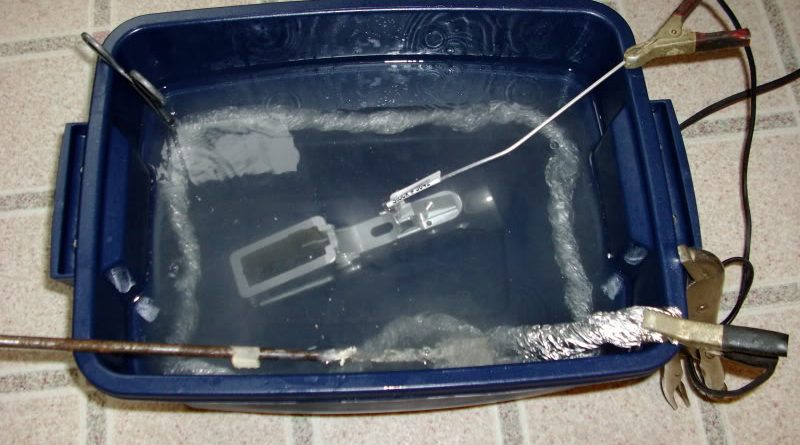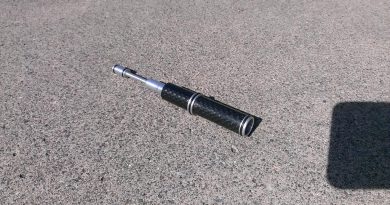Anodize at home
Note: Paintball Times not responsible for damage, injury or any other results of following these procedures. Dangerous chemicals used.
Based on the number of companies selling, and people looking for, anodizing services for their gun’s aluminum bodies and parts, I wanted to provide this info to the paintballing community. I first came across the process in Super Chevy magazine, in an article about anodizing your own parts and brackets, for a custom touch on your hot rod. (* Original article by Bruce Hampson.) Often anodizing is considered and/or presented as a difficult and expensive procedure. As it turns out, it really isn’t that hard or that pricey.
Supplies Needed: The first thing to do is to get the following things together: First on the list is the most expensive item: a 6 to 12 volt battery charger. This item is what might make this too expensive for some paintballers. I (and most other hot rodders) already have one,for my car. If you don’t, then you will need to pick one up. They run from $45.00 to $110.00 depending on model, functions, etc. While it may seem like a lot, it does have other uses. (You could charge a battery, for example.) =) The next item, though not that expensive, will take some effort to find: battery electrolyte, a.k.a. sulfuric acid. This should be available at a battery wholesaler for about $2.00/gal. To make the negative ground, you will need some aluminum ground wire and aluminum-foil. The wire can be found at an electronics store for about $35/spool, and you should have the foil in the kitchen. If you happen to be out of foil, you can pick up some more at the store when you go to buy the last item for this project.
No super-special chemicals or solutions necessary to make the colors; just plain-old fabric dye. (Something like Rit dye, for about $5.00.) Rit offers something like 30-40 different colors, so you have quite a number of choices for what color you want your parts to be. An optional item is nitric acid: about $25.00/2.5 L. (This is used to clean parts prior to anodizing, but there are some cheaper alternatives. See end notes.) This is available at chemical supply stores. Should you not be able to find any, you can try to get on the good side of the high school science teacher. He may help you out since you only need a few ounces.
Safety Precautions: There are a few precautions I want to go over to help keep you from blowing up the house or trashing the garage. First of all, do not mix or store your anodizing solution in a glass container. Something could happen to make it break, and most households are not equipped to deal with that kind of spill. You also don’t want to knock over the container, so a stable, rubber bucket makes a good choice. You will also need to be certain that the part you want to color will fit in the container without sticking out of the solution, and without touching the negative ground in the bottom of the container. Any acid that you don’t use, keep in what it came in, or an old plastic bottle, like a bleach bottle. You can also store your used solution this way for doing more parts later. (Make sure that there is absolutely no bleach left in the bottle. Acid and bleach make chlorine gas. Very bad. Don’t breath. Poisonous.) Safety also applies to the nitric acid, but in a different way. It is imperative that you label and keep track of this stuff, as it is a stronger acid than sulfuric, and more dangerous. The breakage/spill problem is not as likely since you won’t have that much around. (Unless you bought more than a few ounces from the chem store.) The last note about the acids is to mix properly when adding acid and water. Always pour acid into water, never the other way, and do so slowly, being sure to mix in well. There is a reaction taking place and it releases a lot of energy. During the anodizing process, you will be running electricity through a weak acid solution. This creates hydrogen (just like charging a battery) which is very flammable. This stuff burns at the speed of thought when ignited, so do be careful. (Read as Remember the Hindenburg?) Make certain that there is some way to ventilate the project area, and DO NOT let any sources of ignition near the project area. Other precautions you should take include safety glasses, rubber gloves, and maybe some sort of drop sheet under the area.
Preparations: One of the most essential things you need to do in order to get even color over the whole part is to be sure that the part is absolutely clean. You want it free of all contaminates, from dirt to the oils in your skin. This is where the nitric acid and some rubber gloves will help. A solution of 1-2 ounces of nitric acid in a gallon of distilled water will allow you to clean the surface in preparation for the anodizing. Aluminum oxidizes very quickly when exposed to air, so the easiest way to keep it clean is to clean it just before you are ready to start working on the piece. (You should rinse the part with distilled water before you put it in the next acid solution.) Other options are carburetor or brakes cleaners, or other similar degreasers. Soap and water will work also, or cleaners like Simple Green. These are cheaper, a nitric acid wash is the best. (You decide, it’s your money.) =) Make your negative ground with the aluminum wire and foil. Shape the end of the wire into a paddle shape and cover the round part with the foil. What you want to do is create a flat, round shape to sit on the bottom of the bucket, with a lead that comes up out of the bucket. You will clip the battery charger’s negative lead to the wire that comes out of the bucket. When you are ready to start, you will want to mix up your immersion solution. In your rubber bucket, combine the sulfuric acid and water to come up with a solution that is about 30% water. (1 part water to 2 parts acid.) Place the paddle in the bucket and attach the negative lead. Then attach the positive lead to the part, making it an anode, and immerse it in the solution. (Remember that the two leads the paddle (cathode), and the part (anode) should not touch.) This is the best time to turn on the charger: once the part begins to fizz, leave it in there for about 10-15 minutes. After about this time the part should no longer conduct electricity. (You can also use an ohmmeter to check conductivity, but this is not needed.) Turn off and disconnect everything, and rinse the part in cold water. Don’t use hot water! You’ll find out why in the next section.
A couple of notes: I have read some other procedures that say it is important that the copper lead from the charger does not enter the acid solution. The article says nothing about this, and shows a picture with the lead right in there. It may take some trial and error to find out if this is a problem. It wouldn’t be a bad idea to get some scrap aluminum and play with it before you start anodizing your real equipment.




